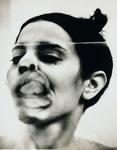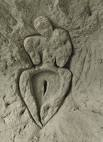This research work aims to analyze the works of a famous Cuban-American artist, Ana Mendieta. In particular, we need to focus on such issues as the dominant motifs in her photographs, sculptures, and performances. Secondly, it is of the crucial importance to trace the sources of artistic influence, and the way in which she incorporated them into her own style. Furthermore, we should discuss the symbolism of her art; because it always renders a powerful but often concealed message. Finally, it is necessary to present various interpretive approaches to her images.
There are many books or scholarly articles, dedicated to the study of this woman, and none of them must be overlooked, but probably, the most comprehensive and compelling analysis is provided by Jane Blocker in her book Where is Ana Mendieta?, the author examines not only the impact of the artists background on her works, but also discusses the main themes and concepts that Mendieta explores.
Overall, she is often regarded as a prominent representative of postmodernism in visual arts, thus the principles of this movement, are palpable practically in all her sculptures and performances, namely, we may speak about such concepts as the death of the author. The essence of this tenet lies in the following: the viewer may interpret a work of art in his way, and his opinion may not necessarily be in agreement with that one of the authors. Mendietas photographs or video recordings can be discussed from various perspectives and may have drastically different meanings. She deliberately wants the spectator to be unbiased and unprejudiced in his or her analysis. Apart from that, it should be mentioned, that the major ideas of postmodernism also find their reflection in the symbols, which she conjures up.
Yet, this is just a general overview; we can draw more specific examples, suggesting that Ana Mendieta was in part relying on the ideas expressed by Vito Acconci and Carolee Schneemann (Blocker, 1999, p 4). We should first remember his short film Claim that is often considered as a brilliant example of performance art, in which he tried to render the feelings of a frightened and isolated person. The most peculiar feature of this movie is that the artist actually performed the main character, and thus he merged the author and his work into a single entity.
It would not be an exaggeration to say that such amalgam became the intrinsic characteristic of Ana Mendietas style. In this regard, we should not forget about Carolee Schneemann, who is also renowned for her live performances. She attached primary importance to sexuality and gender roles, later these questions were frequently analyzed by Mendieta. Regarding this particular issue, we must examine the early projects such as Facial Hair Transplant and Glass on Body.
In these photographs, the author explores such a notion as gender identity. It stands to reason that her pictures are multidimensional, and may be analyzed from various standpoints. Yet, it appears that the main idea, which she wants to render, is that gender identity is a very fluid concept, and very often it is extremely difficult to draw a borderline between the two sexes. While working on this project, Mendieta performed such an operation: she transplanted the beard of a man on her face and photographed herself. As a result, we can observe that there are very few distinctive characteristics, which distinguish a male from a female (See picture 1).
Later, Mendieta develops this idea and advances even a more radical one, like for instance the loss of gender identity. To substantiate this statement we should refer to the collection of her photographs entitled Glass on Body. Naturally, she does hint at some neutral sex, but perhaps she argues that sometimes we pay attention only to the physiology of an individual (either man or woman), and ignore his or her inner world. In this series, the author closely leaned her face over the glass and took a picture of it (See picture 2). The distorted image of a human face signifies a person, who is torn between effeminate and masculine natures in oneself.
Perhaps, such phenomenon as the loss of identity should not be limited only to gender questions, it may also be discussed within the context of cultural heritage. It should be taken into consideration that Mendieta is of Cuban origin, her family lived in this country but she was moved from there at a very young age, and most importantly she was brought up by foster parents (Viso, 2008, p 22). It seems that such experience was almost bound to produce an indelible impression on her creative work. On the whole, one may say that she was trying to unite Western European and Latin American art.
As far as this aspect is concerned we should undoubtedly examine the influence of the so-called Santeria; it is a syncretic religion, which seeks to reconcile beliefs that are often incompatible with one another. Santeria weaves Christianity (or Catholicism to be more exact) into the beliefs of Native Americans. We need to point out that it is extremely ritualistic. Therefore, Mendieta attempted to present a work of art in the form of a ritual.
Traditionally, this genre is classified as earth body, which means that any work created in this style is transient or momentary; it exists only for a certain time, after that it disappears (Blocker, 1999, p 24). One can preserve it using a photo or video camera, but the overall effect will be considerably diminished. As for this particular aspect, we may speak about several projects. It should be taken into account that sometimes they do not have any name; Ana Mendieta did not want to call them in any way, because she expected the viewers to evaluate them without her prompts. First and foremost, we may remember the Death of Chicken (or Beheading of Chicken).
This performance was not received very successfully and the audience was not quite sure as to possible interpretations but this work only brought out the major artistic principles of Mendieta, namely the brevity of art, itself. In addition to that, she wanted to show that a work of art is not static, but dynamic. In this case, we should mostly speak about the influence of postmodernism, whose representative rejects traditional aesthetic dogmas. They believe that a masterpiece is not some kind of physical object or commodity, which can be kept, stored, and possessed. In their opinion, it is something ephemeral, disappearing immediately when the artist completes it. Certainly, such a statement may seem rather unusual, to say the least. The thing is that postmodernists insist that any work of art should be preserved in the memory of the person.
To some extent, Mendieta followed this principle. Among her most famous projects, executed in such a manner, we can mark out the Fetish Series and Feathers on Woman. Nonetheless, we must not limit her contribution only to sheer aesthetics. She was not a supporter of the popular slogan “art for art’s sake”. On the contrary, she always intended to reflect on some social or philosophical problems. In the vast majority of cases, her projects were motivated by some events that had taken place in her life or the lives of her friends.
For instance, we may mention her rather controversial Rape Scenes. The author decided to portray this particular issue because one of her friends was violated (Viso, 2008, p 66). Thus, Mendieta was determined to show all the brutality, which women so often have to face. In her works, the artist always attaches primary significance to the naked body of a woman. If we discuss this nakedness in terms of the feminist movement, we may argue that Mendieta mostly concentrates on sexuality. Namely, she wants to tell that men often regard a woman as an object of sexual desires, and completely ignore her inner world.
Subsequently, such form of relations between both sexes is mostly based on the use of brutal force, but one can hardly speak about any harmony or equality of male and female. The main problem is that even now there are some women, who think only about their sexuality, turning themselves into some kind of commodity. Mendieta cries against such behavior, and the rape scene is an appeal to both sexes.
Apart from that, the famous artist examines racial relations. She was a Cuban who was often treated by others as non-white, someone who does not fully belong to this society. Her earthwork Venus Negra (or Black Venus, if we translate this expression into English) is designed to express her feeling of estrangement from other people, who always looked at her with some uncertainty or even apprehension (See picture 6). In part, this earth sculpture is the embodiment of her tragedy, being alien to people, surrounding her.
Some of her performances were videotaped and became rather popular, at least in artistic circles; for example, Rock Heart with Blood, or Ocean Bird Wash up. Yet, it has to be admitted, Ana Mendieta opposed the idea of her art being videotaped. Thus, we may say that the author was partly influenced by the principles of modernism, especially, if we are speaking about the disappearance of art, but she was also drawing her inspiration from Latin American religious and cultural tradition.
According to Jane Blocker, Mendieta was always longing to regain her cultural heritage. The motif of exile and alienation often reoccur in her pictures, performances, or sculptures. The whole tragedy of her situation lied in her alienation or estrangement from the traditions of her compatriots; this was one of the underlying causes of her avid interest in Santeria and Taino culture. In this way, she was strengthening the ties between herself and her native land. This passion for Taino culture manifests itself many times, in particular in Fetish Series, in which the artist constantly employs such symbols as water, fire, rock, and blood.
The impact of Taino culture becomes perceptible in her Jaruco caves sculptures. According to the traditional beliefs of Indians, caves gave birth to the first human beings. They regard the earth itself as a living entity, which has a will of its own. Mendieta sculptures represent this birth, the ties between mankind and nature, or even between mother and children (See picture 5). She is intent on proving that the so-called primitive art may also convey very elaborate messages. She is so interested in earthworks because they underline the idea of unity between a person and the environment.
However, we should not state that the Fetish series are motivated only by the feeling of nostalgia; they have multidimensional and have several layers of meaning. To prove this argument, we should provide some theoretical background of Santeria and Taino culture. As it has been mentioned before, Santeria is a synthesis of Catholicism and the religious beliefs of Native Americans. Yet, the essence of this synthesis lies in the unity of nature and human beings. In traditional Western philosophy, these notions are always separated from one another. Moreover, the human being is believed to be the pinnacle of Gods creation and all other creatures are treated as inferior to homo sapiens. Indians do not share this opinion, they are firmly convinced that a human being is just a part of nature, but it does not necessarily mean that he or she is superior to others in any way.
Ana Mendieta explores this idea, a great number of her works signify the unity of a person and environment. The author found several ways to express this concept: sometimes she covered her naked body with grass and moss, thus creating some kind of connection between herself and the earth (See picture 3). Arguably, the most eloquent picture is often called A Live Tree (See picture, 4).
Another peculiarity of these pictures is her nudity. Certainly, this feature can be interpreted from various points of view, but it seems that this artistic manner also originates from Santeria and Taino. We may remember also Christianity and especially the fall of Adam and Eve, who had been naked before they were banished from Paradise. To some degree, her pictures symbolize this return to the Garden of Eden.
On the whole, we must acknowledge that the interpretation of Mendietas photographs or performances has always been a subject of heated debate. We cannot presume that there is only one approach. On the contrary, one may suggest at least three frameworks, such as feminist criticism of Julia Kristeva, deconstructive analysis, developed by Jacques Derrida, and the critical theory, proposed by Jacques Lacan. These scholars represent two opposing schools of philosophy and art criticism.
According to Jacques Derrida, we should think mostly about our impressions while analyzing and interpreting any work of art. The essence of deconstruction lies in the following: we rely on certain stereotypes or widely held beliefs while analyzing art, and subsequently, we are unable to assess a book, a musical piece, or painting objectively. He insists that people must first make their assessment, even though their opinion may be contrary to well-established beliefs. Furthermore, Jacques Derrida claims that the reader or viewer must disregard the personality of the author. Only in this way, we can assume an unbiased attitude towards art. In this respect, we should say that Ana Mendieta always wanted the viewers to act in this manner; this is the reason why many of her projects are untitled because the title itself already influences the spectator. In sharp contrast with him, Julia Kristeva and Jacques Lacan stated that the personality of the artist was the most important aspect and we should primarily get insights into his or her life, before analyzing the work, itself (Culler, 1983, p 55).
Mendieta’s projects might be discussed from both these perspectives, but it appears that constructivism is more effective because the artist is relying on her personal experience and her photographs reflect the authors quest for identity both gender, ethnical, and even racial. On the one hand, she was torn between American and Cuban cultures, and secondly Mendieta was trying to establish herself as a woman, not bound by traditional stereotypes, and the semiotics of her photographs and sculptures only confirms this belief. We have described some of them before, namely earth, fire, water, representing the basic elements of nature. Moreover, we should mention her constant use of blood, which is a token of her devotion to Cuban and Latin American tradition, namely Santeria.
Therefore, we can conclude that Ana Mendietas works may be analyzed from various standpoints. Her style indicates that this woman had always been in quest of her ethnic, racial gender identity. Her interest in Taino culture and Santeria religion indicates that the author was desperate to regain her cultural heritage. Whereas, such projects as Hair Transplant or Venus Negra aim to show her struggle against male chauvinism and racism in modern society. We can mark some of the major of her sculptures, photographs, for instance, the relations between man and woman, and the ties between a human being and the environment.
Bibliography
Catherine Twomey Fosnot (2005). “Constructivism: Theory, Perspectives, and Practice”. Teachers College Press.
Jane Blocker, Ana Mendieta (1999). “Where is Ana Mendieta?: Identity, Performativity, and Exile” Duke University Press.
Jonathan Culler (1983). “On deconstruction theory and criticism after structuralism”. Routledge.
LINDSAY ARTURO (1996). “Santeria Aesthetics in Contemporary Latin American Art”. Smithsonian Institution Press.
Marsha Meskimmon (1996). “The art of reflection: women artists’ self-portraiture in the twentieth century” Columbia University Press.
Olga Viso (2008). “Unseen Mendieta: The Unpublished Works of Ana Mendieta”. Prestel Publishing.
Olga M. Viso et al 2004. “Ana Mendieta: earth bodyethnicure and performance, 1972-1985”. Hirshhorn Museum and Sculpture Garden, Smithsonian Institution.
Raysa Elena Amador Gómez-Quintero, Mireya Pérez Bustillo (2002). “The female body: perspectives of Latin American artists” Greenwood Publishing Group.
Appendix





